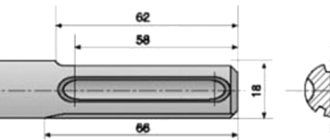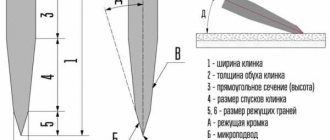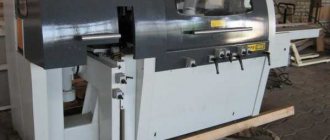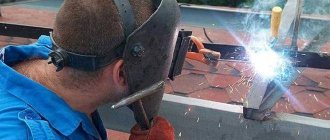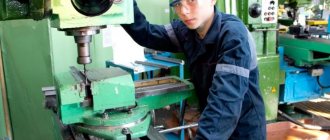Using a band saw is becoming commonplace. Initially, such equipment was used in large sawmills, but today there are a large number of small models for home workshops.
Band saws are highly valued by users for the accuracy and cleanliness of the cut, and the ability to accurately and economically cut the workpiece to thickness. However, saws require sharpening, which requires specialized equipment. The band saw sharpening machine is distinguished by its precision and complexity of design, so it should be examined from all sides.
Description
The band saw blade is equipped with teeth of a certain profile and shape. Productivity, cleanliness of the cut, and stability of the cut depend on the configuration of the notch. The accuracy of the setting and the same shape of all teeth are a very important indicator of the blade, ensuring the quality of the saw. If at least one tooth differs from the rest, the blade may begin to move to the side, which will cause overheating, the appearance of a wavy cut, and failure of the saw.
The sharpening machine is designed for processing teeth, giving them a given shape and setting them. After processing, all teeth receive exactly the same profile and setting. This ensures cutting accuracy, allows you to achieve high productivity from the saw, and increases the service life of the blade to the calculated value.
The sharpening machine operates in automatic mode. The user only needs to install the blade correctly and select the desired processing mode. After this, all that remains is to observe the work and stop processing in time (after completing a full circle).
Typology of paintings
The basis for the division of saws of this type is the material of manufacture and the elements being processed. In accordance with such aspects, the following types of canvases can be distinguished.
- Wood saws. The key materials for their manufacture are carbon and alloy steels; their hardness reaches 40–45 HRC. All teeth are subject to mandatory hardening with high-frequency currents. It should be noted that this blade material can be used for cutting thin non-ferrous metals or carbon steels.
- Canvases for metal. Such tools are made from high-speed or spring steel (cobalt and tungsten are added to the structure). These saws already carry a strength of up to 69 HRC. To obtain high hardness and broad capabilities, stellite or other types of durable alloys can be welded onto the teeth.
Operating principle
The band saw sharpening machine is a multifunctional unit.
The tape is installed in it and is automatically fed to the cutting element, which rotates on a movable carriage (like a pendulum saw). The size of the machine is relatively small, slightly larger than a sewing machine. One model, depending on its parameters, can work with tapes of different sizes and almost any length. The kit includes the unit itself and an additional support structure that supports the free part of the belt in the desired position.
The sharpening machine ensures the formation of the profile of each tooth. This requires moving the blade by a given amount corresponding to the distance between the teeth (pitch). In addition, it is necessary to change the position of the cutting element so that it repeats (or forms) the profile of the teeth.
The movement of the tape by the length of the tooth pitch is ensured by a special element - a pusher. It is a rod, one end of which lies freely on the working edge of the belt, and the second is connected to an eccentric. Each turn of it causes one movement of the pusher at a distance equal to the pitch of the teeth. To change the pitch, the eccentric is changed or adjusted (depending on the type of design or model of the machine).
The processing of teeth is carried out using a movable spindle with an installed grinding wheel. The axis of its rotation is inclined to the horizontal at an angle that ensures the formation of the front and back sides of the tooth. The profile is formed using a special replaceable cam of complex shape. Each tooth is processed in one revolution of this cam, which raises and lowers the sharpening disk to the desired amount. The combination of vertical and horizontal movement allows you to obtain a specific tooth shape.
The owner has at his disposal a whole set of cams designed to process teeth of different sizes and shapes. Each of them can create only one profile, which is why it is necessary to have a large number of cams to process different types of tapes. There are cams for sharpening belts with large teeth of complex shape (rough cutting), and for processing blades with small “mouse” teeth for a clean and precise cut.
Expert opinion
Levin Dmitry Konstantinovich
Each machine is universal - it can work with different belts and form teeth of one configuration or another. There are models for working with wide and long belts used for sawing logs in sawmills. There are models for sharpening small belts from household machines. They all have approximately the same design, the only difference is in small details.
Specifications
Main parameters of the machine:
- tape width;
- loop length;
- tooth pitch;
- engine power.
All other parameters can be attributed to additional, individual properties of a particular model (desktop version or on its own bed, design of the supporting device, type of cutting element, etc.). This data can be found from the machine passport.
Saw maintenance
To maintain the blades, it is not enough to sharpen the teeth; they also need to be set apart. These two procedures are performed in order of succession: they begin with setting the teeth, and end with sharpening them. This chronology of work must be strictly observed. Dilution is carried out in order to reduce saw friction in the process of cutting a particular material (wood, metal, plastic, etc.). There are several methods of breeding, which depend on what elements need to be obtained after processing and the strength of the starting piece.
How is sharpening done?
Sharpening the tape occurs in stages:
- installing the tape in the machine, adjusting the position of the pusher;
- installing the appropriate cam to obtain the desired tooth shape;
- starting processing, monitoring the process;
- stopping and removing the tape prepared for work.
The whole complexity of the procedure lies in setting up, setting the necessary parameters for moving and the depth of lowering of the cutting disk. When the setup is done properly, nothing else is required or dependent on the wizard - only observation and stopping the process at the right time.
Operating modes
When sharpening belts, two main modes are used:
- Formation of teeth . This is a process in which new teeth are cut, or the profile of teeth already present on the belt is changed. Processing is carried out so as not to overheat and not overload the machine and the blade. Several revolutions are used (there can be quite a lot of them, from 5 to 10), with each of which the processing depth gradually increases.
- Sharpening teeth without changing shape . This is a fairly quick procedure, during which only the cutting edge (edge) of the tooth is renewed. Experienced craftsmen call this process “two-spark sharpening,” since the cutting wheel only touches the very tip of the tooth, actually striking only a couple of sparks.
The choice of mode is made based on the need and the initial state of the teeth. As a rule, sharpening occurs in a light, gentle mode. The belt must be changed every few hours of operation, so too deep processing is usually not required.
Sharpening blades in winter
If everything is clear about sharpening blades under normal conditions, then sharpening in the cold season needs to be said separately. There is a difference in sharpening tape blades in summer and winter cold. It consists of changing the degree of sharpening. The angle that applies to blades in winter should be 90 degrees, in contrast to summer, when the sharpening angle is 120 degrees.
Recommendations from experts.
- When sharpening a blade using a machine, before starting the process, you need to ensure the accuracy of the location of the grinding wheel in relation to the tool.
- It is extremely important to remove such a volume of metal from the recesses so that all microcracks are reliably eliminated.
- If the blade has operated without normal maintenance for a longer time than the manufacturer allowed, the volume of metal removed in one pass must be increased.
- To test the effects of sharpening, always use a new blade as a sample.
- The tooth configuration of the blade is an indicator that has been worked out and adjusted over the years. Therefore, relying on the device to cut “without a hitch,” no matter what you do with the teeth, is a huge mistake.
- If operating standards are followed, the belt web will work conscientiously until the width is reduced to a value equal to 65% of the initial parameters. The width decreases, of course, during sharpening.
- There is absolutely incorrect advice that there is no particular need to remove burrs after sharpening. If you take this into account, then the occurrence of microcracks in the saw is guaranteed.
- Upon completion of the work, the tape blade must be cleaned of chips and resin without shelving, and carefully inspected before sharpening. Otherwise, the risk of contamination of the sharpening discs is very high. And this will certainly lead to a poor-quality sharpening process.
How to choose the right model
The choice of a suitable sharpening machine model is determined by the parameters of the existing band saw. It is necessary to consider equipment capable of processing such belts, which has the appropriate characteristics (tooth pitch, belt thickness, loop length, etc.). Finding the right machine for one band saw is easy.
A much more difficult task is to choose a model to service several saws of different sizes that have their own tooth profile. Sawmills or carpentry shops often use several saws for economical cutting of valuable logs and for clean cutting of thin plates with fine-toothed belts.
In such cases, you have to choose universal type equipment that can work with different tapes and allows quick changeover from one size to another. Experts recommend giving preference to domestic manufacturers who use stronger metal and produce machines with an extended service life.
Useful tips
Sharpening band saws is a dangerous procedure. It is necessary to take into account the specifics of the tape, which is a closed ring. It is forbidden to be inside it; the blade is installed in such a way that the entire loop is on a support behind the machine, and the master is in front of it.
Do you need band saw sharpening?
Constantly! Rarely, but it happens
In addition, the following requirements must be met:
- clothing should be loose, but without hanging ends or ribbons;
- work must be carried out wearing protective glasses and gloves;
- when setting up the machine, you should not immediately start it to the entire depth of processing, you need to increase it gradually;
- It is recommended to process all belts with the same tooth profile at once in order to reduce changeover times and increase productivity.
For beginning craftsmen, it will be useful to consult with experienced specialists and observe their work. Some subtleties are difficult to describe; you have to see them with your own eyes. Experience comes with time, despite the automatic sharpening mode, the quality of the results depends on the master.
